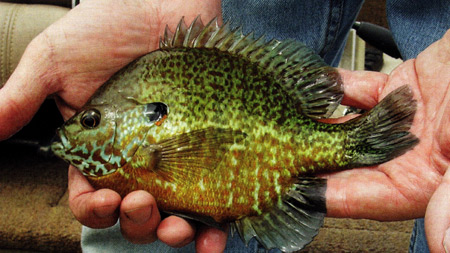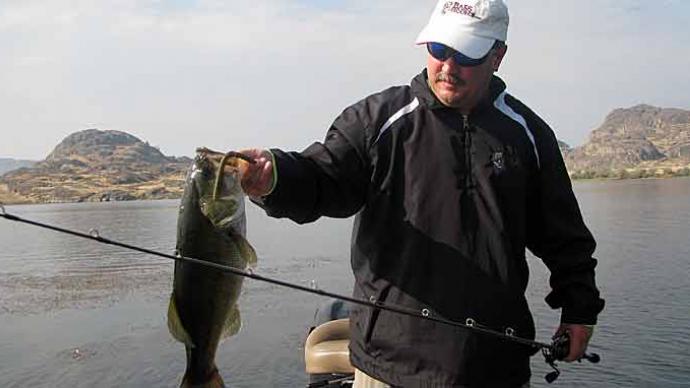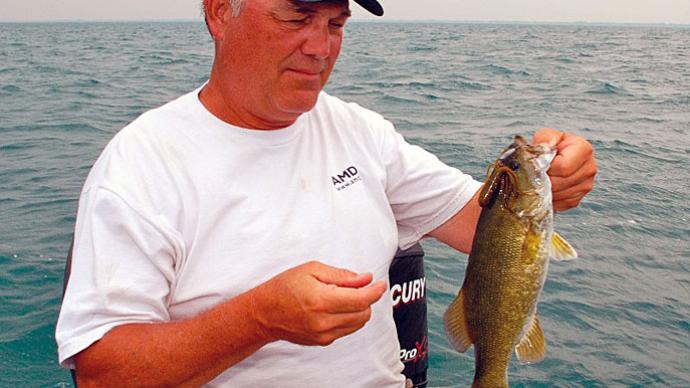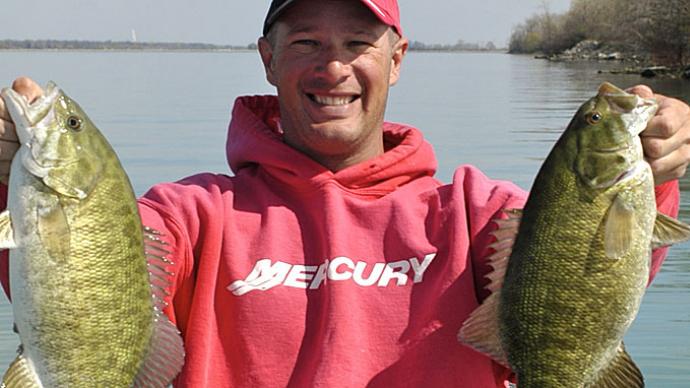
Smallmouth bass sure seem to garner lots of interest from Pond Boss readers. Over the years, especially during the time spent brainstorming with Dr. Dave Willis from South Dakota, we've identified a number of myths and misconceptions about smallies.
One of those misconceptions is that smallmouth bass can only live in cool or cold regions. That's totally untrue. Just ask Aaron Matos. Aaron has grown some outstanding smallies in his part of the nation. I paid him a visit some years ago and his quote was, "You said that 90% of the fish in any given pond live in 10% of that pond. And, that 10% changes from season to season." He's exactly right. I've said that for decades. Still believe it. But Matos took his pond outside that box. He had to. His space and water were limited. He eliminated that 90% where fish can't live and built a small, maybe tenth-acre pond in his backyard, and made it 100% productive. I'll always remember seeing several two-pound plus smallies that couldn't have been much more than three years old. If you stood on top of his dam and leaned a little bit to the left, you could see, drum roll please, downtown Phoenix, Arizona. His water was moving through a manmade wetland filter and was as consistent as water can be. But it was also plenty warm enough to swim in during summer.
Here at LL,2, in north Texas, I stocked several advanced fingerling smallmouth bass about three years ago into our swimming pond next to the house. They share water with six other species. A four-pounder was caught last weekend.
The constraints in the south are totally different than northern waters. In the south, don't expect smallmouth bass to successfully reproduce, for whatever reasons. It's not that they can't or won't spawn, but when they do, survival rates are pretty much nil. However, in the north, expect them to overpopulate, especially where habitat is gravelly.
In your northern ponds, smallmouth habits are fairly predictable. If they have adequate spawning substrate, recruitment is good. Just like Largemouth bass in the south (and in the north), they tend to recruit so well that it's easy to wind up with a bass-crowded population.
One of the biggest issues with smallies is choosing the best forage fish. Bluegills aren't a good choice because they tend to reproduce and grow beyond the mouth size of a typical smallmouth population. That leads to crowded bluegills with crowded smallmouth bass. That means two problems to solve— and there's not an easy solution to either.
What about pumpkinseeds? These fish seem to thrive in waters with some aquatic vegetation. That makes sense, because this sunfish feeds on snails, insects, and crustaceans. Can they be a good forage fish for smallies? That's another big maybe. They, like bluegills, are also multiple spawners each spring and early summer.
If you want to manage for smallmouth bass, you have a pretty delicate balancing act to follow. That means you truly need to understand the makings of your pond and its elements. If you have gravel, smallmouth bass will reproduce. If you have bluegills or pumpkinseeds, they'll reproduce successfully as well. If you have vegetation, sunfish have an advantage.
Understand this, too. When sunfish are present in smallmouth waters, they'll tend to overpopulate and not grow large. Then, they'll disrupt smallmouth spawning, and reduce recruitment of your bass. That's actually a management strategy some people use to minimize or at least balance recruitment of bass. When that happens, we've seen smallmouth bass sizes increase and frequency decrease, and it doesn't take long for that to happen. The moral of this tale is that sunfish are not only used to provide as good a food source as they can be, they can also affect smallmouth bass overcrowding. I'm oversimplifying this dynamic, mainly because these populations can shift quickly back and forth. Part of your job, dear northern pondmeister, is to judge your population and see how it's changing so you can decide what you need to do to adjust it.
For comparison, with Largemouth bass, pond managers aren't nearly as concerned about sunfish overpopulating because Largemouth can keep sunfish numbers in check by eating them. Smallies are much less effective.
Because of the nature of smallies, it's wise to consider other species to help provide forage and food, whether those species assist by providing food, or if they help control the overpopulation tendencies of smallmouth and sunfish.
Here's what I mean.
Walleyes have been used in conjunction with smallmouth, even in fairly small waters. I've seen this combination successful in waters as small as three-acres. Walleyes fit a slightly different niche than bronze backs, although they do tend to come shallow at night to feed. Once they are big enough, walleyes can be effective in harvesting overcrowded sunfish, and even eating small bass.
It's this type of dynamic that makes smallmouth bass management a bit of a challenge. Tweaking and adjusting, based on the response of the fishery, can be the most effective management strategy. That means you need valuable data, especially tracking catch rates and looking at relative weights of those different species. The good news here is that you need to go fishing and keep some records so you can see the shifts and recognize when it's time to alter your harvest plan or do some supplemental stocking.
One big factor we've all seen when it comes to forage and food for smallmouth bass is that we need to take advantage of every opportunity. Think like this—what do smallmouth bass love to eat? Crawfish, small fish, scuds, fathead minnows, native minnows, bigger insects. The more habitat we can develop and add to a pond that encourages these elements, the better your smallmouth will respond.
Providing forage fish for Largemouth bass is easy. All you need are lots of bluegill and other things that fit into its mouth, and you have it. For smallmouth bass, it's a totally different food game. They thrive with diversity, inherently feeding on different food items as they are available. They thrive on native crawfish, when seasonally available. They'll eat baby sunfish, even though they seem to never keep up with or get ahead of sunfish recruitment. They eat dragonfly nymphs, grass shrimp, and scuds—when available, which is seasonal.
If you want to grow smallmouth bass in northern waters, understand the value of evaluating how well each species successfully reproduces, and then decide what to do about the overcrowding tendencies as well as how best to take advantage of the seasonal hatches of those morsels of value. When you figure all these pieces and put a successful smallmouth bass puzzle together, please share it with the rest of us.
Reprinted with permission from Pond Boss Magazine



